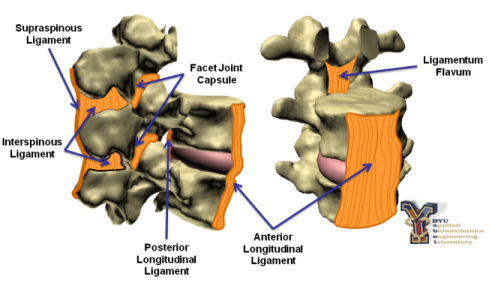- About BABEL
- People
- Research
- Resources
- Technology Commercialization
Spinal Ligament Characterization
Spinal ligaments provide passive control of back motion and help protect the spinal cord from injury while allowing for substantial range of motion of the vertebral column. Like all ligaments, spinal ligaments are highly anisotropic due to their fibrous structure. The fiber orientation in each ligament generally represents an adaptation of the ligament to its mechanical environment. In addition, spinal ligament material behavior is nonlinear, viscoelastic, and strain rate dependent. Alterations to ligament kinematics due to age, intervertebral disc degeneration, and the presence of other chronic degenerative and pain-inducing changes are not well understood, even though these processes have a significant effect on ligament behavior, and thus spine kinematics.
Six major ligaments are generally considered to be relevant in the study of lumbar spine biomechanics anterior longitudinal ligament (ALL), posterior longitudinal ligament (PLL), ligamentum flavum (LF), supraspinous ligament (SSL), intraspinous ligament (ISL), and the facet joint capsule (FJC).
The lumbar spinal ligaments are innervated with mechanoreceptors and mechanonociceptors, which are afferents that respond to their mechanical environment. Evidence exists to support the theory that the lumbar spinal ligaments function proprioceptively and that excitation of ligament mechanoreceptors could contribute to feedback loops initiating paraspinal muscle contraction. Therefore, in addition to the direct contribution of spinal ligaments to passive lumbar spine stability, proper ligament function may play a significant role in contributing to the active support provided by the paraspinal musculature. Elucidating the mechanical behavior of spinal ligaments during different motion types would assist in the study of the normal functioning of the lumbar spine, as well as low back pain mechanisms.
Ligament Microstructure
Like all ligaments, spinal ligaments have a composite structure composed of a proteoglycan-rich matrix reinforced by crimped collagen fibers. When ligaments are damaged, the fibers and matrix are disrupted. In vivo, some ligaments will not self-repair. Those that self-repair exhibit significantly increased randomness in the collagen fiber organization resulting in reduced constitutive properties. In our laboratory, we are investigating the relationship between ligament microstructure (e.g., collagen fiber density, fibril directionality, crimp tortuosity) and material constitutive response.
Anisotropic Punch Testing
Spinal ligaments are small and difficult to grip with regionally variant cross-sectional areas. They exhibit strongly anisotropic constitutive behavior (transversely isotropic along the collagen fiber direction). Like most biological materials, they also exhibit viscoelasticity and strain rate dependence. Traditional material testing techniques are difficult to apply. We are developing a novel variation of the isotropic punch test that has become standard for polymer and metal material characterization.
Related Publications
Hyatt, T., Fullwood, D., Bowden, A.E., Bradshaw, R.J., Johnson, O. (2010). Nano-composite sensors for wide range measurement of strain. Proceedings of the SAMPE 2010 Exhibition & Symposium, Seattle, WA, May 17-20, 2010.
Showalter, B.L., M.B. Hunter, and A.E. Bowden (2009). Validation of a modified small punch test for characterizing the material response of spinal ligaments. Proc 55th Annual Meeting of the Orthopaedic Research Society.
This material is based upon work supported by the National Science Foundation under Grant No. 0952758. Any opinions, findings and conclusions or recomendations expressed in this material are those of the author(s) and do not necessarily reflect the views of the National Science Foundation (NSF).


